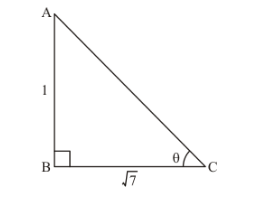If $\tan \theta=\frac{1}{\sqrt{7}}$, show that $\frac{\operatorname{cosec}^{2} \theta-\sec ^{2} \theta}{\operatorname{cosec}^{2} \theta+\sec ^{2} \theta}=\frac{3}{4}$
Given: $\tan \theta=\frac{1}{\sqrt{7}}$....(1)
To show that $\frac{\operatorname{cosec}^{2} \theta-\sec ^{2} \theta}{\operatorname{cosec}^{2} \theta+\sec ^{2} \theta}=\frac{3}{4}$
Now, we know that
Since $\tan \theta=\frac{\text { Perpendicular side opposite to } \angle \theta}{\text { Base side adjacent to } \angle \theta}$...(2)
Therefore,
Comparing Equation (1) and (2)
We get,
Perpendicular side opposite to $\angle \theta=I$
Base side adjacent to $\angle \theta=\sqrt{7}$
Therefore, Triangle representing angle $\theta$ is as shown below

Hypotenuse AC is unknown and it can be found by using Pythagoras theorem
Therefore by applying Pythagoras theorem
We get,
$A C^{2}=A B^{2}+B C^{2}$
Therefore by substituting the values of known sides
We get,
$A C^{2}=(1)^{2}+(\sqrt{7})^{2}$
Therefore,
$A C^{2}=1+7$
$A C^{2}=8$
$A C=\sqrt{8}$
$A C=\sqrt{2 \times 2 \times 2}$
Therefore,
$A C=2 \sqrt{2} \ldots \ldots .(3)$
Now, we know that
$\sin \theta=\frac{\text { Perpendicular side opposite to } \angle \theta}{\text { Hypotenuse }}$
Now from figure (a)
We get,
$\sin \theta=\frac{A B}{A C}$
Therefore from figure (a) and equation (3) ,
$\sin \theta=\frac{1}{2 \sqrt{2}}$...(4)
Now, we know that $\operatorname{cosec} \theta=\frac{1}{\sin \theta}$
Therefore,
$\operatorname{cosec} \theta=2 \sqrt{2} \ldots \ldots(5)$
Now, we know that
$\cos \theta=\frac{\text { Base side adjacent to } \angle \theta}{\text { Hypotenuse }}$
Now from figure (a)
We get,
$\cos \theta=\frac{B C}{A C}$
Therefore from figure (a) and equation (3) ,
$\cos \theta=\frac{\sqrt{7}}{2 \sqrt{2}}$....(6)
Now, we know that $\sec \theta=\frac{1}{\cos \theta}$
Therefore, from equation (6)
We get,
$\sec \theta=\frac{1}{\frac{\sqrt{7}}{2 \sqrt{2}}}$
Therefore,
$\sec \theta=\frac{2 \sqrt{2}}{\sqrt{7}} \ldots \ldots$....(7)
Now, L.H.S of the equation to be proved is as follows
L.H.S $=\frac{\operatorname{cosec}^{2} \theta-\sec ^{2} \theta}{\operatorname{cosec}^{2} \theta+\sec ^{2} \theta}$
Substituting the value of $\operatorname{cosec} \theta$ and $\sec \theta$ from equation $(6)$ and $(7)$
We get,
L.H.S $=\frac{\left[(2 \sqrt{2})^{2}\right]-\left(\frac{2 \sqrt{2}}{\sqrt{7}}\right)^{2}}{\left[(2 \sqrt{2})^{2}\right]+\left(\frac{2 \sqrt{2}}{\sqrt{7}}\right)^{2}}$
L.H.S $=\frac{(4 \times 2)-\frac{(4 \times 2)}{7}}{(4 \times 2)+\frac{(4 \times 2)}{7}}$
$L . H . S=\frac{(8)-\frac{(8)}{7}}{(8)+\frac{(8)}{7}}$
Now by taking L.C.M. in numerator as well as denominator
We get,
L.H.S $=\frac{\frac{(7 \times 8)-8}{7}}{\frac{(7 \times 8)+8}{7}}$
Therefore,
$L . H . S=\frac{\frac{56-8}{7}}{\frac{56+8}{7}}$
L.H.S $=\frac{\frac{48}{7}}{\frac{64}{7}}$
Therefore,
L.H.S $=\frac{48}{7} \times \frac{7}{64}$
$L . H . S=\frac{48}{64}$
L.H.S $=\frac{3}{4}$
$L . H . S=\frac{3}{4}=R . H . S$
Therefore,
$\frac{\operatorname{cosec}^{2} \theta-\sec ^{2} \theta}{\operatorname{cosec}^{2} \theta+\sec ^{2} \theta}=\frac{3}{4}$
Hence proved that
$\frac{\operatorname{cosec}^{2} \theta-\sec ^{2} \theta}{\operatorname{cosec}^{2} \theta+\sec ^{2} \theta}=\frac{3}{4}$
